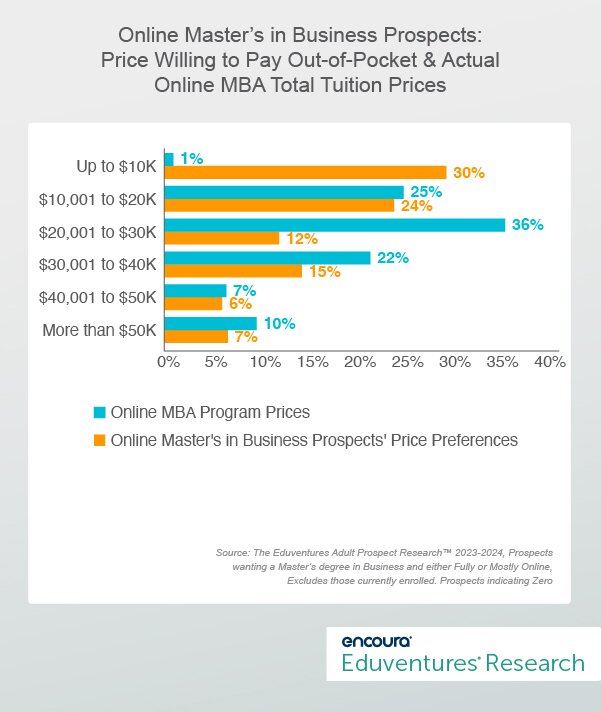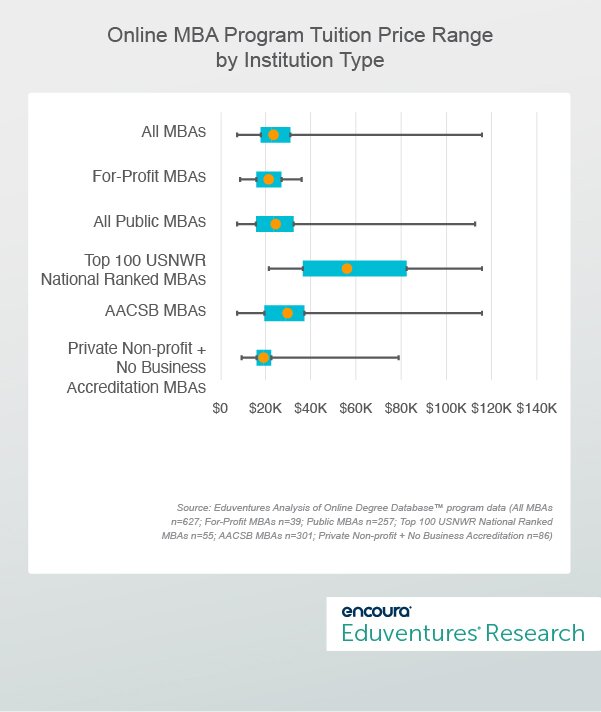The MBA has long been the cornerstone of graduate education, conferring over 100,000 degrees a year for over a decade. It’s also one of the most popular online offerings—70% of MBA programs were fully online by 2023, up from just 50% in 2016.
And demand remains strong: 64% of business schools reported online MBA application growth in 2024, according to the Graduate Management Admission Council, provider of the GMAT.
But in a saturated market, differentiation is tough—and price is emerging as a key battleground. So, what are online MBA prospects willing to pay, and how does that align with program pricing?
No single degree program has seen greater online adoption than the MBA (except perhaps the RN-BSN), aided in part by the Online Program Management industry that helped to launch these programs en masse.
While online MBA programs are as varied as the institutions that offer them, most online master’s degree prospects indicate “affordable tuition and fees” as the feature they care about most when evaluating a program. The question is, what does affordability mean to these prospects?
Price Expectation vs. Price Reality
Figure 1 shows the difference between the price online master’s in business prospects are willing to pay and actual tuition prices of online MBA programs. It’s important to note that these prospects are asked how much they would pay “out of pocket” so some could expect employer benefits and institutional grants/scholarships to defray the cost.
With that in mind, Figure 1 shows that a sizable number (30%) would only pay up to $10,000 out-of-pocket … but don’t slash your online MBA tuition just yet. Only 1% of online MBA programs are actually priced that low.
Another 36% of prospective students are willing to pay between $10,000 and $30,000, and 61% of online MBA programs are priced within this range.

Figure 1.
Among pricier online MBA programs, 39% charge over $30,000 in tuition, which exceeds what 28% of prospective students are willing to pay. While it may be good news that there are prospects willing to pay over $50,000 for an online MBA, it is a small audience.
Overall, the data highlights a gap between what prospects expect and what the market delivers, prompting a closer look at which institutional types tend to have higher total tuition.
Online MBA Segmentation and Price
Further analysis of the online MBA program price data reveals differences by institutional type, ranking, and business accreditation. Figure 2 shows online MBA program price range (minimum and maximum), the middle 50% range, and the median (red dot).

Figure 2.
While total tuition for online MBA programs ranges widely—from just under $8,000 to more than $130,000—half of all programs fall between $20,000 and $35,000 (the middle 50%). Nationally, the median tuition is $25,380, and the average is $30,781. When segmenting online MBA programs by ranking, and institution type, clear pricing differences emerge.
- Top ranked institutions in the top 100 by U.S. News & World Report (USNWR) offer online MBAs that are by far the most expensive, with median tuition of about $62,000 and a 75th percentile of nearly $94,000. These programs carry a significant premium, reflecting the value placed on institutional prestige.
- AACSB-accredited programs also trend higher in program cost, with a median tuition of about $32,000. This reflects the perceived rigor and quality associated with the Association to Advance Collegiate Schools of Business (AACSB) accreditation.
- Public universities offer broad value with median tuition of $26,000, which is close to the national median of $25,000. Notably, 71% of public institutions now charge a single online rate instead of basing tuition on the student’s state of residency.
- For-profit institutions have some of the oldest online MBA programs with the lowest median tuition ($23,000) and the lowest maximum tuition of $40,500, which shows a targeted effort to attract cost-conscious students.
- Private nonprofits with no business accreditation fall at the lower end of the price spectrum with middle 50% ranging from a price of $18,000 to $25,000, indicating limited pricing power without key institution and accreditation factors.
Assessing how an institution compares with others at the national, state, or regional level is a critical first step. From there, programs must decide how to position themselves: either by competing on cost, or by demonstrating the value, outcomes, and distinctiveness that justify a higher price.
The Bottom Line
As schools have added online MBA programs, MBA conferrals have not changed dramatically. This suggests that online MBA programs are drawing students away from campus-based programs rather than growing the overall market.
But changes could be on the horizon. Labor market volatility could be a boost for this market and ease pricing pressures. At the same time, the elimination of GRAD Plus loans starting in 2026 may force higher-priced programs to reevaluate pricing and positioning.
Only time will tell.
For now, institutions are exploring a range of strategies to stand out—from adding unique concentrations to offering accelerated completion options to emphasizing faculty with industry connections.
Price remains a primary factor for many prospective students, and the market remains segmented into distinct pricing tiers by institution type and accreditation. Institutions will also need to more intentionally measure and communicate outcomes—career advancement, salary gains, employability—to justify their prices and to distinguish themselves in a market showing increasing signs of commoditization.

